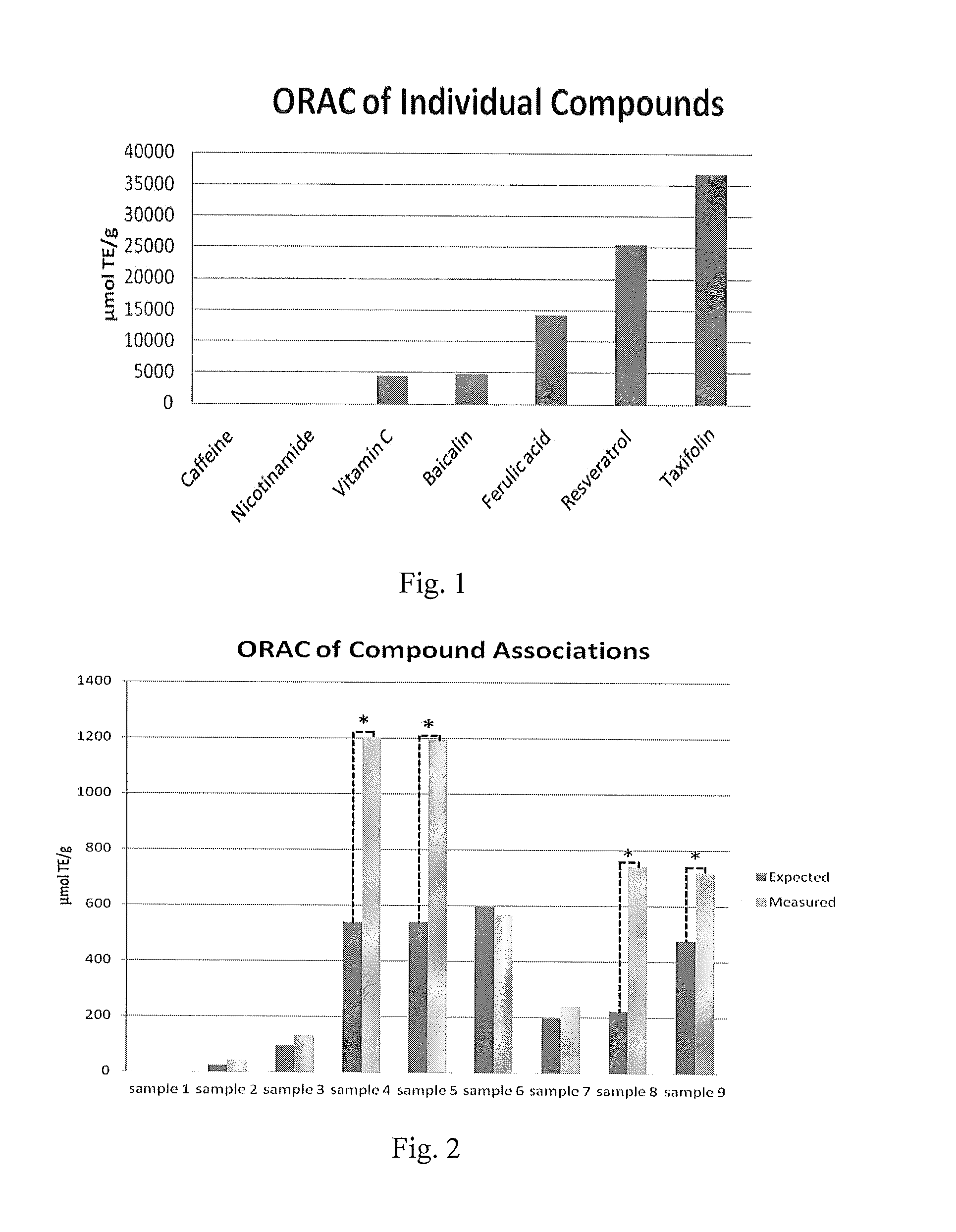Cosmetic compositions containing at least one flavonoid and ferulic acid
- Summary
- Abstract
- Description
- Claims
- Application Information
AI Technical Summary
Benefits of technology
Problems solved by technology
Method used
Image
Examples
example 1
[0048]To test samples by using ORAC, compounds are dissolved into water-based NaH2PO4 buffer. Therefore, usually only hydrophilic compounds can be tested in this assay. Although the required concentration is very low in the assay and certain organic solvents such as ethanol or acetone can be used to help solubilization, there is still some issue for certain compounds with very limited solubility. Here, by using hydrotropes, clear water-based solutions could be prepared for antioxidant associations. These solutions were used to test the ORAC of different associations. The hydrotropes used, caffeine and nicotinamide, have been tested both individually and in solution to make sure that they have no influence on the capacity of antioxidant compounds.
[0049]All the antioxidants selected for association design show potent capacity in ORAC assay, while hydrotropes which just been used to increase the solubility of certain antioxidants have no capacity by themselves. The results of individua...
example 2
Preparation A: Serum
[0053]
PhaseComponentWeight % of totalAPropylene glycol10ADipropylene glycol10AEthanol10AFerulic acid0.5ABaicalin0.4BWater49BVitamin C10BCaffeine5BNicotinamide5BBaicalin0.1
[0054]Preparation A is made as follows using the above listed components.
[0055]The glycol phase (Phase A) components were mixed together at 65° C. except ethanol. After obtained a clear solution and cooled it down to room temperature, ethanol was added. At the same time, the aqueous phase (Phase B) components were mixed at room temperature till clear solution was obtained. The glycol phase was then added into the aqueous phase with constant stirring for another 1 hour and the desired serum was obtained. The final PH was adjusted to 4.5 by using NaOH.
example 3
Preparation B: Cream
[0056]
PhaseComponentWeight % of totalA1Water57.5A1Nicotinamide5A1Caffeine5A1Baicalin0.5A1Resveratrol0.5A1Ferulic acid0.5A2Glycerin10A2Xanthan gum0.2A2Preservatives1BDicaprylyl carbonate3BDimethicone3BDicapryl alcohol and ceteareth-204BGlyceryl stearate and PEG-1004.5stearateCDimethicone ammonium4CPolyacryloyldimethyl taurate0.3DNylon-121
[0057]Preparation B is made as follows using the above listed components.
[0058]Phase A1 components were mixed at room temperature in sequence until a clear solution was obtained. In separate containers, Phase A2 was pre-suspended, and then added into Phase A1 with constant stirring and heated to 65° C. At the same time, Phase B components were mixed and completely dissolved at 65° C. Then Phase B was added into Phase A and emulsified for 10-15 minutes. Heating was then stopped, and mixing continued. Phase C was added and mixed for another 10 minutes. After the temperature fell below 40° C. Phase D was added and mix for 10-15 minut...
PUM
| Property | Measurement | Unit |
|---|---|---|
| Antioxidant | aaaaa | aaaaa |
Abstract
Description
Claims
Application Information
 Login to View More
Login to View More - R&D
- Intellectual Property
- Life Sciences
- Materials
- Tech Scout
- Unparalleled Data Quality
- Higher Quality Content
- 60% Fewer Hallucinations
Browse by: Latest US Patents, China's latest patents, Technical Efficacy Thesaurus, Application Domain, Technology Topic, Popular Technical Reports.
© 2025 PatSnap. All rights reserved.Legal|Privacy policy|Modern Slavery Act Transparency Statement|Sitemap|About US| Contact US: help@patsnap.com

